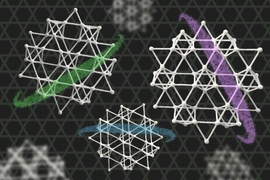MIT professors Senthil Todadri and Xiao-Gang Wen are members of the newly established Simons Collaboration on Ultra-Quantum Matter. The effort, funded by the Simons Foundation, is an $8 million four-year award, renewable for three additional years, and will support theoretical physics research across 12 institutions, including MIT.
The science of the collaboration is based on a series of recent developments in theoretical physics, revealing that even large macroscopic systems that consist of many atoms or electrons — matter — can behave in an essentially quantum way. Such ultra-quantum matter (UQM) allows for quantum phenomena beyond what can be realized by individual atoms or electrons, including distributed storage of quantum information, fractional quantum numbers, and perfect conducting boundary.
While some examples of UQM have been experimentally established, many more have been theoretically proposed, ranging from highly entangled topological states to unconventional metals that behave like a complex soup. The Simons Collaboration on Ultra-Quantum Matter will classify possible forms of UQM, understand their physical properties, and provide the key ideas to enable new realizations of UQM in the lab.
Ultra dream team
In particular, the collaboration will draw upon lessons from recently discovered connections between topological states of matter and unconventional metals, and seeks to develop a new theoretical framework for those phases of ultra-quantum matter. Achieving these goals requires ideas and tools from multiple areas of theoretical physics, and accordingly the collaboration brings together experts in condensed matter physics, quantum field theory, quantum information, and atomic physics to forge a new interdisciplinary approach.
Directed by Professor Ashvin Vishwanath at Harvard University, the collaboration comprises researchers at MIT, Harvard, Caltech, the Institute for Advanced Study, Stanford University, University of California at Santa Barbara, University of California at San Diego, University of Chicago, University of Colorado at Boulder, University of Innsbruck, University of Maryland, and University of Washington.
“I am looking forward to scientific interactions with MIT theorists Senthil and Wen, who are key members of our Simons collaboration on Ultra-Quantum Matter, and hope this will further strengthen collaborations within the Cambridge area and beyond. Their research on highly entangled quantum materials is of fundamental significance, and may provide new directions for device applications, quantum computing, and high-temperature superconductors,” says collaboration director Ashvin Vishwanath of Harvard University.
“They have also been mentors for several collaboration members,” says Vishwanath, who worked with Senthil as a Pappalardo Fellow in physics from 2001 to 2004.
Senthil has played a leading role in the field of non-Fermi liquids, in the classification of strongly interacting topological insulators and related topological phases, and in the development of field theory dualities with diverse applications in condensed matter physics.
Wen is one of the founders of the field of topological phases of matter, introducing the concept of topological order in 1989 and opening up a new research direction in condensed matter physics. Wen’s research has often exposed mathematical structures that have not appeared before in condensed matter physics problems.
MIT-grown
Of the 17 faculty members who are participating in the collaboration, more than half, including Senthil, Wen, and Vishwanath, have MIT affiliations.
Michael Hermele, the collaboration’s deputy director and an associate professor at the University of Colorado at Boulder, was a postdoc in the MIT Condensed Matter Theory group.
Associate professors Xie Chen PhD ’12 and Michael Levin PhD ’06, at Caltech and the University of Chicago, respectively, earned their doctorates at MIT under Wen.
Other principal investigators include alumni Subir Sachdev ’82, now chair of the Department of Physics at Harvard, and Leon Balents ’89, a physics professor at UC Santa Barbara's Kavli Institute for Theoretical Physics. John McGreevy, a string theorist who conducted research in the Center for Theoretical Physics (CTP), is now a professor of physics at UC San Diego. Dam Thanh Son and Andreas Karch, former CTP postdocs, are now with the University of Chicago and the University of Washington, respectively.
The collaboration is part of the Simons Collaborations in Mathematics and Physical Sciences program, which aims to “stimulate progress on fundamental scientific questions of major importance in mathematics, theoretical physics and theoretical computer science.” The Simons Collaboration on Ultra-Quantum Matter is one of 12 such collaborative grants ranging across these fields.
The first meeting of the newly established collaboration will take place Sept. 12-13 in Cambridge, Massachusetts.









